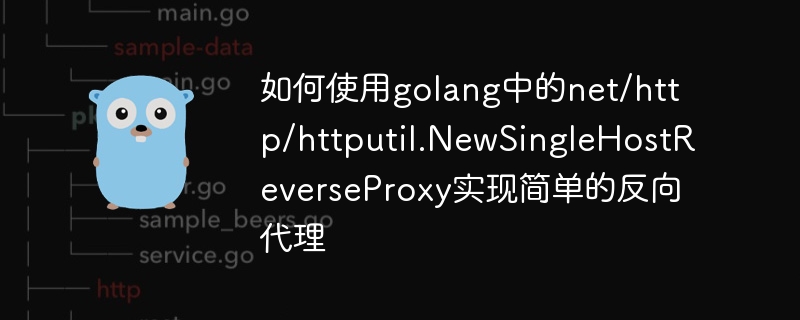Home >Backend Development >Golang >How to use net/http/httputil.NewSingleHostReverseProxy in golang to implement a simple reverse proxy
How to use net/http/httputil.NewSingleHostReverseProxy in golang to implement a simple reverse proxy
- PHPzOriginal
- 2023-11-18 11:25:10862browse

How to use net/http/httputil.NewSingleHostReverseProxy in golang to implement a simple reverse proxy
1. Introduction
In modern Internet applications, reverse proxy The agent is a very important component. It enables load balancing and improves application scalability and reliability. Golang's standard library provides a very convenient method httputil.NewSingleHostReverseProxy, which can implement the reverse proxy function simply and quickly. This article will introduce how to use this method to implement a simple reverse proxy through detailed code examples.
2. Principle of reverse proxy
Reverse proxy is the middle layer between the client and the server. The client sends a request to the reverse proxy server, and the reverse proxy server then proxies the request to Processed on the actual server. The communication between the client and the server is done through a reverse proxy server, thus achieving decoupling between the client and the server.
3. Use httputil.NewSingleHostReverseProxy to implement reverse proxy
- Import the required packages
First we need to import the relevant packages, including "net/http" and "net /http/httputil".
import (
"net/http"
"net/http/httputil"
)- Create a reverse proxy object
Next, we need to create a reverse proxy object. You can call the httputil.NewSingleHostReverseProxy function to create a reverse proxy object. This function needs to pass in a parameter of type url.URL to specify the URL of the target server to be proxied.
func NewSingleHostReverseProxy(target *url.URL) *ReverseProxy
The sample code is as follows:
targetURL, _ := url.Parse("http://api.example.com")
proxy := httputil.NewSingleHostReverseProxy(targetURL)- Custom processing function
In order to realize the reverse proxy function, we need to customize a processing function. Will be called by the http library to handle the request. The processing function needs to implement the ServeHTTP method of the http.Handler interface.
func (h *Handler) ServeHTTP(w http.ResponseWriter, r *http.Request) {
response, err := http.Get("http://localhost:8080")
if err != nil {
http.Error(w, err.Error(), http.StatusInternalServerError)
return
}
defer response.Body.Close()
// 将原始请求的header复制到响应中
for key, values := range response.Header {
for _, value := range values {
w.Header().Add(key, value)
}
}
// 将原始请求的body复制到响应中
_, err = io.Copy(w, response.Body)
if err != nil {
http.Error(w, err.Error(), http.StatusInternalServerError)
return
}
}- Register the processing function
Finally, we need to register the processing function on the default router of the http library so that it can respond to client requests.
http.HandleFunc("/", handler.ServeHTTP)- Start the reverse proxy server
The last step is to start the reverse proxy server.
http.ListenAndServe(":8080", nil)4. Sample code
The following is a complete sample code that proxies requests from localhost:8080 to api.example.com.
package main
import (
"io"
"net/http"
"net/http/httputil"
"net/url"
)
type Handler struct{}
func (h *Handler) ServeHTTP(w http.ResponseWriter, r *http.Request) {
targetURL, _ := url.Parse("http://api.example.com")
proxy := httputil.NewSingleHostReverseProxy(targetURL)
proxy.ServeHTTP(w, r)
}
func main() {
handler := &Handler{}
http.HandleFunc("/", handler.ServeHTTP)
http.ListenAndServe(":8080", nil)
}The above code can be run by executing go run main.go, and then visit http://localhost:8080 in the browser to see the effect of the proxy.
5. Summary
This article introduces how to use the httputil.NewSingleHostReverseProxy method in golang to implement a simple reverse proxy. With a few simple steps, we can quickly and easily build a reverse proxy server to implement request forwarding and load balancing. Reverse proxy is a very important part of Internet applications. Knowing how to use related tools and techniques will be very helpful for developing and maintaining large distributed systems. I hope this article has inspired you, thank you for reading!
The above is the detailed content of How to use net/http/httputil.NewSingleHostReverseProxy in golang to implement a simple reverse proxy. For more information, please follow other related articles on the PHP Chinese website!

